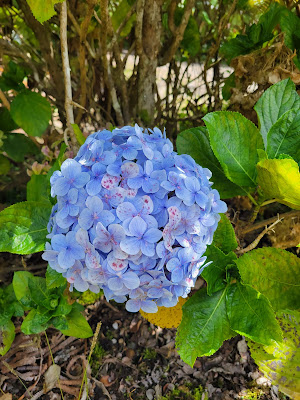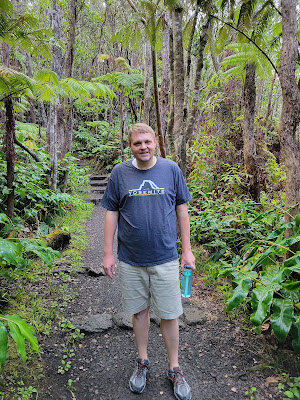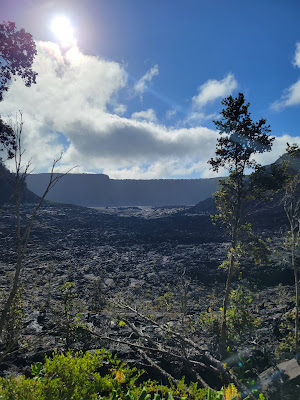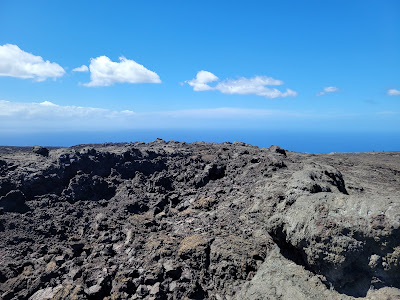Visited: September 2023
Nearby city: Hilo, HI
"A spectacle, sublime and even appalling, presented itself before us. We stopped and trembled. Astonishment and awe for some moments rendered us mute, and, like statues, we stood fixed to the spot, with our eyes riveted on the abyss below."
-British missionary William Ellis, the first Westerner to observe an eruption at Kilauea in 1823
Hawai'i Volcanoes National Park protects and preserves two volcanoes: (1) Kilauea (one of the world's most active volcanoes); and (2) Mauna Loa (the world's largest active volcano). It covers over 320,000 acres on the southern coast of the island of Hawaii (aka, the "Big Island"). The Park was established on August 1, 1916.
We had a great adventure exploring this Park. We stayed at a lovely bed & breakfast near the Park Entrance in a small town called Volcano Village. The hotel was tucked away in the jungle and Tara really enjoyed all the beautiful flowers.
breakfast of banana bread and a papaya bowl
Our first stop at the Park was the Kilauea Iki Crater. Kilauea Iki is a pit crater next to the main Kialuea Caldera. The Kilauea Iki Crater underwent a massive eruption in late 1959 that filled the crater with a lava lake. The lake has now cooled and you can hike down into the crater and walk across the lava flow. This was an awesome hike. The loop trail is approximately 4 miles.
the Kilauea Iki Crater. In the background, Mauna Loa (elevation: 13,679 ft) looms on the horizon.
overlook of the Kilauea Iki Crater. The eruption lasted from November 14, 1959 to December 20, 1959
we finally reached the bottom of the crater
walking on the cooled lava lake was very fun and unique
Make sure to take a short detour off the Kilauea Iki Loop Trail to walk through the Thurston Lava Tube. A lava tube is a type of lava cave formed when a low-viscosity lava flow develops a hard crust that thickens and forms a roof above the still-flowing lava stream. As the lava empties from the tube, it leaves a cave.
We also took the mile-long Devastation Trail to see more of the effects of the 1959 eruption at Kilauea Iki.
At the conclusion of our hike of the Desolation Trail we saw some nene (the Hawaiian Goose) in the parking lot.
We then took the scenic drive along the Chain of Craters Road. The road goes through a bunch of lava flows from the 1960s and 1970s and then drops down to the Pacific Ocean. The expansive views along the road were incredible.
At the end of the road, take a short walk to see the Holei Sea Arch. It was really neat to see giant waves crash against the 90-ft tall arch jutting out into the ocean.
We also took a short hike (just under 2 miles) to see the Pu'uloa Petroglyphs. Pu'uloa (meaning "long hill" or "hill of long life") is a sacred site that contains hundreds of petroglyphs carved into the pahoehoe lava bedrock.
Along with the petroglyphs are these small holes. For many generations, native Hawaiians would come to this site, drill the holes into the lava rock, and place their newborn baby's umbilical cord into the hole, hoping for a long life for their children.
We then went back to the Crater Rim Road and stopped at the overlook at the main Kilauea Caldera. If you're hoping for the chance to see lava flow/eruption, this is the place to see it. The deepest part of the caldera, the Halema'uma'u Crater, is one of the most active volcanic spots on earth. The caldera was particularly active in 2018, and significant portions of the crater rim road (including all the trails in the caldera) have been closed since then. Unfortunately, we were not lucky enough to see any lava or eruptions. But, wouldn't you know it, shortly after we returned home from Hawaii, the crater began to erupt again. Oh well...that's how nature goes sometimes. 😃
overlook of the Kilauea Caldera and the Halema'uma'u Crater
According to Hawaiian mythology and tradition, Halema'uma'u Crater is home to Pele, the goddess of fire and volcanoes
Near the Crater rim you will find dozen of steam vents. These steam vents occur when water seeps into the ground below. When the water comes in contact with the hot magma beneath the surface of the Kilauea Caldera, it vaporizes and returns to the surface as steam.
the steam arising from the vents was quite hot.
Mauna Loa on the horizon
We had an absolute amazing time at Hawai'i Volcanoes National Park. It was such a cool, unique place and no visit to the Big Island would be complete without a stop at the volcanoes.
For more info on the National Park: https://www.nps.gov/havo/index.htm
After a long day of hiking and exploring we celebrated with some great food & drink. 😁


























































































































No comments:
Post a Comment